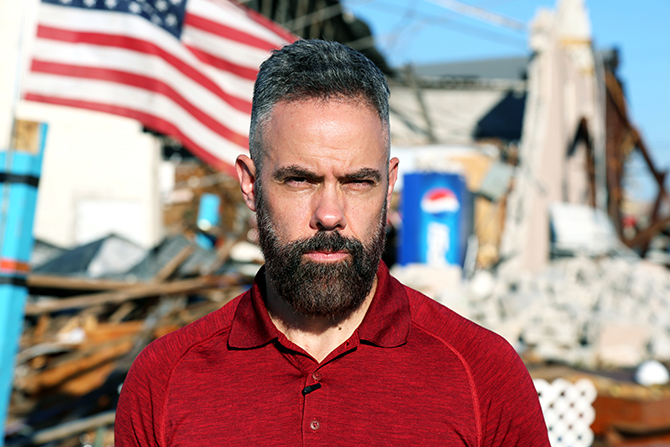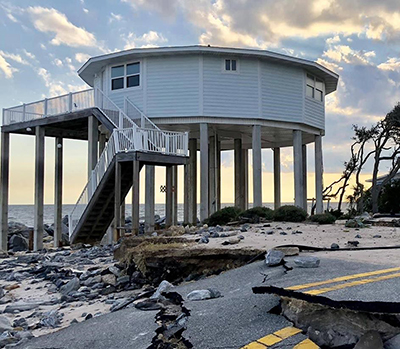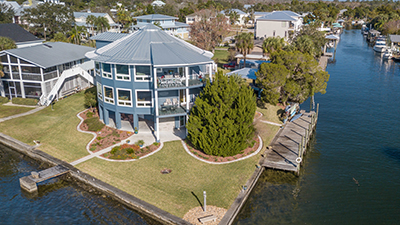From Bomb Cyclones To Hurricanes
How To Keep Home and Family Safe

By Melissa Clark and Lori Zelenko
Bomb Cyclones, the winter weather phenomenon that can be as damaging as hurricanes, are bearing down upon us. Snow and sleet and ice are coating the Northeast and with some of us sheltering in place in summer homes along the coast, and even inland where winter weather troubles not to mention tropical storms dare to disturb, it’s not pretty, in fact, it’s scary. No magical winter wonderland for us as windowpanes shake and a nor’easter drives surf over the dunes. Images of softly falling snow or gentle rain are for the movies not for the life we are living as climate change - and the relocation repercussions of covid-19 upend norms.
THE TROUBLE STORMS BRING
2020 had thirty named storms, breaking records set more than a century ago. Though bomb cyclones or blizzards may not take advantage of the Greek alphabet, the trouble they bring can equate a hurricane.
The world’s most renowned hurricane chaser Josh Morgerman looks back over the past hurricane season and observes such damaging weather goes in cycles; this year was particularly bad or as he puts it “busy.” Hurricanes will, in general, subside and then pick up every 10 – 30 years. Morgerman clarifies, "We seem to be now in a busy phase for United States Hurricanes emanating from the Atlantic. From 2006 – 2016 we were on the quiet side; however, things started to pick up in 2017 with Maria smashing Puerto Rico, and Michael devastating Florida. The patterns signal that next year could be busy as well. 2018 was the year of Hurricanes Michael and Florence. In 2019, Dorian, Humberto, and Lorenzo strengthened at category 5, and 2020 ended with Iota.”
Morgerman has survived being in the eye of 54storms, he has risked being beheaded or electrocuted, seen concrete buildings tumble down around him, evacuated children at risk and appeared on global news networks to report on conditions only a professional hurricane chaser could withstand. We asked him for solid advice on how to survive storms - from hurricanes to bomb cyclones.
STORM SURVIVAL PLAYBOOK
·Don’t pay attention to seasonal predictions. They don’t really matter to a coastal resident. You can have a busy season where every hurricane stays offshore, or you can have a dead season where the one bad storm comes right to your town. Be ready.
·Build above the maximum possible storm surge. When you build a new home, know the history of that region. What was the worst (benchmark) hurricane or winter storm there, and how high did the storm surge get? Ideally, you’ll build well above whatever that line is. I have to say I have seen it all. I am extremely impressed with Deltec homes – and they are the only homes standing after an entire community is wiped out. They are specially engineered and can withstand winds of 185 miles per hour. However, no home—no matter how well-engineered—escapes major damage if storm surge gets in. Water is extremely destructive.
Take action to protect your home (and yourself) from wind damage—before and during a hurricane:
Way before
- When it comes to homes proven to withstand Category-5 winds (up to 185 mph) the only ones I have seen that stay intact are Deltec - they make round homes that resist the wind.
- If your home isn’t a Deltec home, you can reinforce it—for example, by ensuring the roof is securely connected (where the roof connects to the walls is often a weak point) with hurricane straps and installing impact-glass windows, among other steps to protect your home.
Right before
- Listen to your local news and municipalities regarding evacuation orders. This is very important and can be life-saving.
- Cover windows with shutters or boarding. Windows are a house’s Achilles heel. Oftentimes, the major damage to a house or building happens once a window breaks and the wind gets inside the structure. Keep the wind out!
- Don’t bother taping windows. It’s an old tradition that doesn’t help.
During
- If you unexpectedly get trapped in your home, ride out the storm in an interior room—preferably one with no exterior walls.
- If the house starts to fail, such as windows breaking or roof or walls tearing off, get inside a closet or bathroom and cover yourself with a mattress or pillows.
- Keep windows sealed during the storm. It’s an old myth that you want to open windows to “ventilate” the house and let the wind “pass through.”

Don’t assume something can’t happen just because it hasn’t yet. When making life-and-death decisions—for example, whether to evacuate for a hurricane or a winter storm i.e. a bomb cyclone at home—don’t rely solely on your past experiences. Every time a storm hits it is different. Example: Some Mississippians didn’t evacuate their homes for Hurricane KATRINA (2005) because they’d ridden out Category-5 Hurricane CAMILLE (1969) in their homes, and they believed nothing could be worse than CAMILLE. Some paid with their lives. Always do as instructed by the National Hurricane Center and your local officials.
Beware! Hurricanes and Winter Storms i.e. Bomb Cyclones can change intensity very suddenly. A storm’s intensity fluctuates during its lifecycle. It can get strong, then weak, then strong again. The science of predicting hurricane intensity is primitive, and we’re often surprised. Hurricanes may unexpectedly intensify—sometimes rapidly—just before hitting land. Rapid intensification (RI) just before landfall is always a forecaster’s biggest concern. Therefore, always be ready for an intense storm. Even if that approaching storm is only a Category 1, just know that it could suddenly escalate in those final hours and come in much stronger than expected. Examples this year include LAURA (in Louisiana) and SALLY (in Alabama). MICHAEL of 2018 (in Florida) is another great example.
FLYING MISSILES ARE NO PICNIC
Steps to prevent damage to your home may be obvious but surprisingly over-confidence about the severity of the approaching storm leads to "flying missiles,” i.e. outdoor furniture or equipment left outside to be tossed by terrible winds. Says Morgerman, “keeping windows closed and boarding them will prevent shattered glass from flying debris." Wind is a beast that will blow your house down especially if you let it inside. Keep windows closed. Don’t risk letting that beast invade. Morgerman wants to dispel all old wives tales including the belief that taping windows will prevent breakage. What works for windows is storm-resistant glass not a few yards of masking tape. Secure windows are the storm barrier you need to sustain safety.
Morgerman advises that damage can be limited if you take storms - summer, spring, winter or fall - seriously. Build for your environment - and take weather from storm surges (i.e. water) to wind into consideration. Or consider retrofitting your home to withstand weather damage that is no longer seasonal, hurricane season may end by winter but bomb cyclones and blizzards step in to replace the threat.

BEYOND SUSTAINABLE HOMES—RESILANT HOMES
Steve Linton, president of Deltec Homes (www.deltechomes.com) is deeply committed to green building - inside and out, “we build net-zero energy homes that produce their own energy, we can change the equation so that our homes are contributing energy instead of draining it.” The mission Linton has set for Deltec is to naturally connect people - and the buildings they inhabit - with the planet. From the integrity this point of view represents, he respects Morgerman’s advice and adds his own plans to keep people and planet safe in the face of weather disturbances which we must - in the face of climate change - be prepared to sustain. “We are focused on the details of building the most durable home possible for the harshest weather,” today harsh weather conditions along the Atlantic coast can occur from inland locations like the Hudson River Valley to coastal destinations like Hamptons or the Jersey shore, much less Florida from the panhandle to South Beach. Of course, there are communities that live prepared for storm surge and resulting damage, and others that don’t anticipate the upheaval a surprising or even expected storm can cause.
Storms don’t operate on a rhyme or reason; they are as Morgerman says “eccentric.” Understanding this, Linton observes that Deltec’s “continual focus on innovation means that we are always looking to raise the bar: this year we are working on a new Deltec design framework that will allow our homes to be designed to resist up to 225 mph winds. We have set the goal to resist 250 mph wind speeds by 2025.”

CATEGORY SIX STORMS COMING SOON?
There is talk after the past 30-storm season about creating a Category 6 hurricane designation, although a Category 5 already equates to just about total destruction. Though there is a technical difference between 157 mph winds and 200 mph winds, there is little practical difference in terms of destructive force. Bomb cyclones (winter’s answer to a hurricane, explosive force and dropping barometric pressure) or Tropical cyclones (i.e. hurricanes), bring hazards with them that extend beyond the measurement of maximum sustained windspeed, other threats - like rainfall or storm surge - do just as much damage.
Linton and Morgerman want those in the path of a storm at any time of year not to shrug off the risk. Underestimate the damage potential of a Category 1 hurricane much less a Bomb Cyclone at your own risk. If you cannot build from day 1 to stay safe from storm damage, then learn all you can about how storms in your location may have behaved in the past - and how they could possibly behave in the future. Disregard conventional wisdom. Educate yourself. Invest in wind-resistant windows, sandbag against water damage/storm surge…take every precaution to protect yourself, your home, and your family no matter what the season. Just because your home is still standing after 30 storms doesn’t mean it’s a sure thing it will make it through a 31st - named or unnamed.




